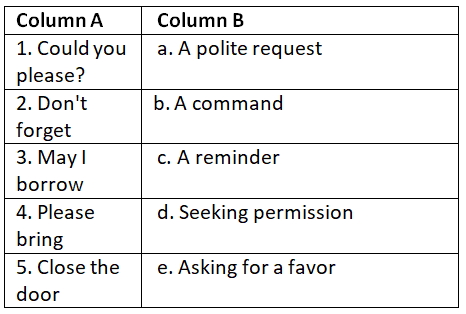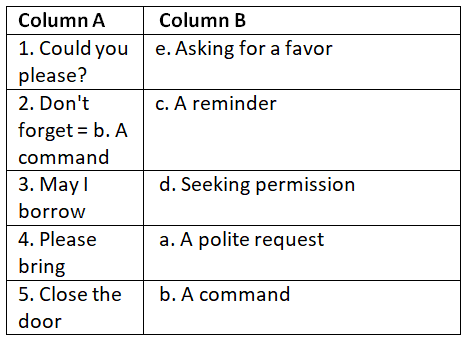Worksheet Solutions: Commands and Requests | English Grammar Advanced - Class 10 PDF Download
| Table of contents |

|
| Section A: Multiple Choice Questions |

|
| Section B: Short Questions |

|
| Section C: Fill in the Blanks |

|
| Section D: Match the Column |

|
| Section E: True or False |

|
Section A: Multiple Choice Questions
Q.1. Which of the following is the correct definition of a command?
(a) A polite way to ask someone to do something.
(b) A statement that expresses a strong request or directive.
(c) A sentence that ends with a question mark.
(d) A type of question that seeks information.
Ans: (b)
Explanation: A command is a type of sentence that expresses a strong request or directive, indicating what someone should do.
Q.2. What is the main difference between a command and a request?
(a) A command is more polite than a request.
(b) A request is a question, whereas a command is a statement.
(c) A command is a directive, whereas a request seeks cooperation.
(d) There is no difference; the terms can be used interchangeably.
Ans: (c)
Explanation: A command is a direct instruction or order, while a request seeks cooperation or permission.
Q.3. Which of the following sentences is an example of a command?
(a) Could you please pass the salt?
(b) Can you tell me the time?
(c) Shut the door before leaving.
(d) Would you like a cup of tea?
Ans: (c)
Explanation: This sentence is an example of a command as it gives a direct instruction without seeking cooperation or permission.
Q.4. In a command, the subject of the sentence is usually ___________.
(a) You
(b) I
(c) They
(d) He/She
Ans: (a)
Explanation: In commands, the subject of the sentence is usually "You," indicating the person who is being addressed.
Q.5. Which punctuation mark is typically used at the end of a command?
(a) Period (.)
(b) Comma (,)
(c) Exclamation mark (!)
(d) Question mark (?)
Ans: (a)
Explanation: Commands typically end with a period (full stop) to indicate a firm directive rather than a question or exclamation.
Section B: Short Questions
Q.1. Define a request in the context of communication.
Ans: A request is a form of communication where someone asks for something, seeks permission, or solicits assistance.
Q.2. Give an example of a command that can be used in a classroom setting.
Ans: Example answer: "Please bring your textbooks to class tomorrow."
Q.3. Explain the importance of using polite language while making requests.
Ans: Using polite language while making requests is important as it shows respect, consideration, and enhances the likelihood of cooperation.
Q.4. What is the role of body language in conveying commands effectively?
Ans: Body language plays a crucial role in conveying commands effectively as it can emphasize the directive, establish authority, and convey confidence.
Q.5. How can commands and requests be used to establish authority and influence?
Ans: Commands and requests can be used to establish authority and influence by expressing expectations clearly, setting boundaries, and motivating others to take specific actions.
Section C: Fill in the Blanks
Q.1. A command is a type of _______ that expresses a request or directs someone to do something.
Ans: A command is a type of sentence that expresses a request or directs someone to do something.
Explanation: A command is a type of sentence that gives an order, instruction, or request to someone.
Q.2. In a command, the subject is usually _______.
Ans: In a command, the subject is usually implied.
Explanation: In a command, the subject is often not explicitly stated but is understood to be "you" or the person being addressed.
Q.3. A command usually ends with a _______.
Ans: A command usually ends with a period (full stop).
Explanation: A command is typically punctuated with a period at the end, indicating a complete sentence.
Q.4. A _______ command is a polite way of making a request or giving an order.
Ans: A indirect command is a polite way of making a request or giving an order.
Explanation: An indirect command is a more polite or courteous way of making a request or giving an order.
Q.5. A _______ command is a direct and forceful way of giving an order or making a request.
Ans: A imperative command is a direct and forceful way of giving an order or making a request.
Explanation: An imperative command is a direct and forceful way of giving an order or making a request.
 |
Download the notes
Worksheet Solutions: Commands and Requests
|
Download as PDF |
Section D: Match the Column
Match the words/phrases in Column A with their corresponding meanings in Column B.
Ans:
Section E: True or False
Q.1. A command always ends with an exclamation mark.
Ans: False
Explanation: A command usually ends with a period (full stop), not an exclamation mark.
Q.2. An indirect command is a more polite way of giving an order.
Ans: True
Explanation: An indirect command is a polite way of making a request or giving an order.
Q.3. The subject of a command is always explicitly stated.
Ans: False
Explanation: The subject of a command is often implied and not explicitly stated.
Q.4. "May I have some water, please?" is an example of an imperative command.
Ans: False
Explanation: "May I have some water, please?" is an example of an indirect command, not an imperative command.
Q.5. "Stop talking!" is an example of an imperative command.
Ans: True
Explanation: "Stop talking!" is a direct and forceful way of giving an order, making it an imperative command.
|
54 videos|155 docs|40 tests
|
















